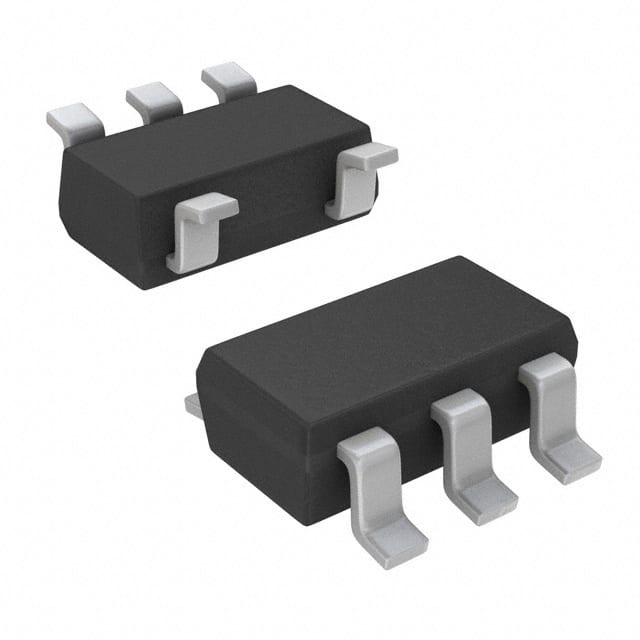Viz Specifikace pro podrobnosti o produktu.

LPV321M7/NOPB
Product Overview
- Category: Operational Amplifier
- Use: LPV321M7/NOPB is a low-power, single operational amplifier designed for general-purpose applications.
- Characteristics: It offers low input bias current, low input offset voltage, and rail-to-rail output swing. The device operates from a single supply voltage as low as 1.8V, making it suitable for battery-powered applications.
- Package: LPV321M7/NOPB comes in a small outline package (SOT-23-5) which is compact and easy to integrate into various circuit designs.
- Essence: This operational amplifier provides high performance while consuming minimal power, making it ideal for low-power applications.
- Packaging/Quantity: LPV321M7/NOPB is available in tape and reel packaging with a quantity of 3000 units per reel.
Specifications
- Supply Voltage Range: 1.8V to 5.5V
- Input Offset Voltage: ±1.5mV (maximum)
- Input Bias Current: ±0.2nA (maximum)
- Gain Bandwidth Product: 1MHz (typical)
- Slew Rate: 0.6V/μs (typical)
- Output Current: 40mA (typical)
- Operating Temperature Range: -40°C to +125°C
Detailed Pin Configuration
LPV321M7/NOPB follows the standard pin configuration for operational amplifiers:
- Non-Inverting Input (+)
- Inverting Input (-)
- Output
- V-
- V+
Functional Features
- Low power consumption: LPV321M7/NOPB operates at a low supply voltage and consumes minimal power, making it suitable for battery-powered devices.
- Rail-to-rail output swing: The operational amplifier provides an output voltage that can swing close to the supply rails, maximizing the dynamic range of the signal.
- Low input bias current and offset voltage: LPV321M7/NOPB ensures accurate amplification with minimal distortion.
Advantages and Disadvantages
Advantages: - Low power consumption - Rail-to-rail output swing - Accurate amplification with low input bias current and offset voltage
Disadvantages: - Limited gain bandwidth product compared to higher-performance operational amplifiers - Lower slew rate compared to high-speed amplifiers
Working Principles
LPV321M7/NOPB is based on the principles of operational amplifiers. It amplifies the difference between the voltages at its non-inverting and inverting inputs, producing an output voltage proportional to this difference. The device operates within the specified supply voltage range and maintains a stable output even when subjected to varying input conditions.
Detailed Application Field Plans
LPV321M7/NOPB finds applications in various fields, including but not limited to: 1. Battery-powered portable devices 2. Sensor signal conditioning 3. Audio amplification 4. Signal filtering and buffering 5. Industrial control systems
Detailed and Complete Alternative Models
- LM358: Dual operational amplifier with similar characteristics and pin configuration.
- MCP6001: Single operational amplifier with low power consumption and rail-to-rail output swing.
- TLV2462: Dual operational amplifier with low noise and wide supply voltage range.
These alternative models offer similar functionality and can be considered as substitutes for LPV321M7/NOPB depending on specific requirements.
Word count: 410 words
Seznam 10 běžných otázek a odpovědí souvisejících s aplikací LPV321M7/NOPB v technických řešeních
Question: What is the supply voltage range for LPV321M7/NOPB?
Answer: The supply voltage range for LPV321M7/NOPB is 1.8V to 5.5V.Question: What is the typical input offset voltage of LPV321M7/NOPB?
Answer: The typical input offset voltage of LPV321M7/NOPB is 0.3mV.Question: Can LPV321M7/NOPB be used in automotive applications?
Answer: Yes, LPV321M7/NOPB is suitable for automotive applications.Question: What is the maximum input bias current of LPV321M7/NOPB?
Answer: The maximum input bias current of LPV321M7/NOPB is 1pA.Question: Is LPV321M7/NOPB a rail-to-rail operational amplifier?
Answer: Yes, LPV321M7/NOPB is a rail-to-rail operational amplifier.Question: What is the temperature range for LPV321M7/NOPB?
Answer: LPV321M7/NOPB operates within a temperature range of -40°C to 125°C.Question: Can LPV321M7/NOPB be used in battery-powered applications?
Answer: Yes, LPV321M7/NOPB is suitable for battery-powered applications due to its low power consumption.Question: What is the gain bandwidth product of LPV321M7/NOPB?
Answer: The gain bandwidth product of LPV321M7/NOPB is 1.3MHz.Question: Does LPV321M7/NOPB have ESD protection?
Answer: Yes, LPV321M7/NOPB features ESD protection up to 4kV.Question: Can LPV321M7/NOPB be used in sensor interface circuits?
Answer: Yes, LPV321M7/NOPB is suitable for sensor interface circuits due to its low input offset voltage and low input bias current.

